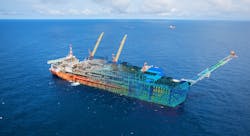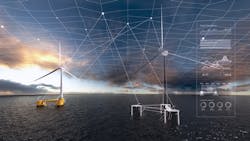The offshore energy industry is increasingly using digital twin technology to enhance efficiency and safety, reduce maintenance and operating costs, and support asset life extension. Coupled with sensors, the virtual representation of a physical asset and its behavior allow operators to obtain greater insights in order to improve inspection, maintenance, and repair (IMR).
There have been a number of digital twin developments over the past year. Recently, Akselos SA deployed a structural digital twin for Shell Nigeria Exploration and Production Co.’s FPSO Bonga. The structural digital twin, which is based on Akselos’ patented reduced-basis finite element analysis technology, is said to be able to realize a number of operational objectives. These include the identification of critical areas for prioritized IMR; a reduction in personnel on board the asset; reduced necessity for physical inspections in hard-to-reach areas such as cargo tanks; and to support scenario planning for extreme weather events and asset modification.
The deployment of the simulation technology, the company said, will also enable safe asset life extension by replacing the over-conservative estimates made with conventional software with accurate assessments that reflect actual remaining fatigue life.
The FPSO Bonga, which became operational in 2005 at the Bonga oil field, has a capacity of 225,000 b/d and weighs more than 300,000 metric tons (330,693 tons), making it the largest asset in the world to be protected by a structural digital twin, the company claimed.
Also, Akselos has signed a distributor deal with Lamprell. Under the terms of the agreement, the UAE-headquartered fabrication, engineering, and contracting firm will be the sole distributor of Akselos’ software to any asset the company has designed, constructed, delivered, or assessed across 13 countries in the Middle East North Africa region and other nominated projects. The deal will enable Lamprell to offer engineering simulations for the optimized design, delivery, and maintenance of wind farm foundations, jackup rigs, FPSO modules, and other offshore assets.
Meanwhile, DNV GL and Bluewater are working on a pilot project involving the use of hybrid digital twin technology to predict and analyze fatigue in the hull of the FPSO Aoka Mizu, currently operating at Hurricane Energy’s Lancaster oil field west of Shetland. They aim to validate and quantify the benefits of creating a virtual replica of the FPSO in order to optimize the vessel’s structural safety and support risk-based inspection (RBI).
DNV GL said its domain experience, inspection capabilities, and digital analytics and modeling enable monitoring of the asset’s hull structure during operation without having to rely on costly routine inspections.
The concept, known as ‘Nerves of Steel,’ involves combining various data sets (external environmental data or local sensor data) with digital models of the asset to develop a hybrid replica model of the vessel’s structure. This can be used in real time to monitor the vessel’s condition, identify and monitor high-risk locations, and to plan cost-efficient maintenance and inspection.
Hybrid twin technology uses numerical design models and data from actively recorded strain gauge sensors onboard the vessel that are said to provide a full understanding of the accumulative loading and current state of the FPSO structure.
Computer-simulated modeling blended with real-time data is then streamed to the operator via DNV GL’s Veracity data platform or an existing data transfer solution. The company’s visual dashboard provides Bluewater with data on stresses in the hull’s structure and information that can be used to identify areas at relatively higher risk of cracks or deformities. The information, which is constantly recorded, can be accessed and analyzed to support decisions and to enact inspections based on risk priority.
The trial will expand on traditional FPSO integrity management strategies, which are centered on software-based assumptions made at the design stage as well as the current inspection record to enhance RBI decision-making. The pilot with Bluewater is expected to provide new insight and smarter ways of managing risks and costs related to structural integrity management.
Francois-Xavier Sireta, technical lead for naval architecture and principal engineer, DNV GL – Oil & Gas, said: “Like an insurance policy, the hybrid digital twin can potentially save millions by avoiding the costly and possibly catastrophic repercussions of ill-informed integrity management by pre-empting and preventing detrimental damage.
“For an asset operating in a harsh environment, where the loads play an important part in the possible degradations…, using data from the site as a basis for optimized inspection planning, alarms for extreme events, and asset suitability for life extension is crucial.”
This is the company’s third pilot project evaluating the performance of hybrid digital twin technology. The first involved defining a repair procedure for a FPSO flare tower. The second, which is still ongoing, is being performed on a fixed offshore platform.
Elsewhere, Shell has signed an enterprise agreement with Kongsberg Digital for digital twin software to be deployed across its assets and capital projects. The Kognitwin Energy Software-as-a-Service solution will provide integration, visualization, and analytics capabilities to Shell’s global assets. It will be supplied through the company’s cloud-native Kognitwin Energy digital twin service platform, which will integrate and contextualize real-time sensor data, historical data, engineering information and other transactional business data across a variety of data sources. This is expected to enable the company to improve work processes and optimize facility performance through digitalization. It is also expected to expand the scope of its remote operations.
The industry push for advanced digital twin technologies has also led to new alliances. This past summer, DORIS Group, Schneider Electric, and AVEVA joined forces to deliver digital twin technology for the upstream oil and gas market. They will combine their engineering capabilities to provide an asset lifecycle software solution and digital specialization in order to create a fully formed digital twin.
In addition, FutureOn recently entered a partnership with Bentley Systems to speed up digitalization of the oil and gas industry. It involves combining FutureOn’s field design application (FieldAP) and its collaboration platform (FieldTwin) with Bentley’s iTwin platform to deliver a digital twin solution applicable to upstream project design methodologies over the next decade.
On another front, Bureau Veritas claims its digital twin/smart data asset management tool can cut offshore decommissioning costs by 9-15%. The company’s data, which it has shared with the UK’s Oil and Gas Authority, indicates that the Veristar AIM3D system could save operators more than £2 million ($2.46 million) on project costs for platforms with topsides of 10,000 metric tons (11,023 tons), increasing to more than £8.5 million ($10.47 million) for topsides up to 40,000 metric tons (44,092 tons).
Bureau Veritas developed the tool with Dassault Systèmes to provide a 4D picture of an asset’s condition instantly, on any platform or device, at any time. It combines a digital twin of an offshore or marine facility with smart data, and according to the company, allows operators to speed up decisions on improving efficiency, safety, integrity, performance, returns on investment, and reducing carbon footprint.
The system, said to provide a mirror image of an asset, is designed to improve work scope definition and execution efficiency while at the same time lowering costs. The increased visibility is also said to support risk mitigation and safety leading potentially to lower insurance premiums.
The company estimates savings from 9% to more than 30% are possible for decommissioning activities ranging from topsides and jacket removal to subsea infrastructure, facilities ‘de-energizing’, operator costs, onshore recycling and site remediation and monitoring.
It has identified 54 North Sea facilities with topsides of 10,000-40,000 metric tons that it believes could benefit of the new 4D tool to cut decommissioning costs, and 35 others of less than 10,000 metric tons that could benefit in late life operations through to decommissioning phases.
Finally, digital twins are expected to play a role in the emerging offshore wind market.
The California Energy Commission has awarded Aker Solutions and Cognite a $2-million grant for a project called NextWind Real Time Condition Monitoring. This project aims to develop a holistic digital solution that will enable monitoring the condition of an offshore floating wind farm and its impact on the environment via live data streaming.
A digital twin model of physical offshore wind assets will be developed to assess conditions and integrity management. This real-time information will allow access and analysis of data to help reduce operating expenses and maintenance costs by improving production efficiencies.
About the Author
Jessica Stump
Editor
Jessica Stump is editor of Offshore Magazine. She uploads and writes news to the website, assembles surveys and electronic newsletters, and writes and edits articles for the magazine. She was the summer editorial intern at Offshore in 2009 and 2010 before joining full time in April 2011. She has a journalism degree from Texas Tech University.


